Opabinia regalis
The body size of Opabinia ranges between 43mm and 70mm, excluding the frontal proboscis. The trunk is divided into a main portion consisting of almost equal size of 15 segments and a short posterior portion lacking segmentation. The length of head is equal to approximately 2 or 2.5 segments, and the posterior portion of trunk is about 3 segments in length, and has three pairs of thin blades of tail fan. The frontal proboscis is 4 times longer than the head 4).
Consequently, Opabinia was about 100mm in the maximum length, including the frontal proboscis 3).
The distal portion of proboscis expands and is divided into two opposing claws which have some spines on each insides. The proximal portion of proboscis may have had flexibility and might have been able to rotate to some extent. The mouth opens on the posterior wall of the head and faces to the rear. The gut start from the mouth to the forward, turns drawing U-shape at soon, and runs along the length of body 4). The claws would have been able to grasp soft food items and carry them towards its mouth 3), 4). Five eyes are on the short stalks projecting from the dorsal side of head, and each eyes seems to be a compound eye 4).
Each segments of trunk has a pair of lateral lobes extending downward and outward, and the gills are attached on the lobes 2), 4). Opabinia may have moved the lateral lobes undulatory, and swam slowly.
Opabinia had no jaws 4). Opabinia may have seeked soft preys, remain of animals, or sedimental organic materials in the bottom mud, using its proboscis.
When Harry Whittington, who "was the first to highlight how some of the Burgess Shale animals differ markedly from those that populate today's oceans" 2), showed the earlier version of his reconstruction of Opabinia at the Palaeolontological Association conference in Oxford in 1972, "it was greeted with loud laughter" 4). So much so that the creatures of the Cambrian were beyond the common sense imagination of the time. Now, Opabinia is so popular and familiar fossil animal with Anomalocaris, Tyrannosaurus 2).
The phylogenetic placement of Opabinia will be in the arthropod stem groups, but the morphological controversies, that is, whether Opabinia had lobe limbs or not, still remains 1), 2), 3).
Greenish felting model has no lobopods.
Browny felting model has lobopods.
References:
- Budd GE, Daley AC (2011) The lobes and lobopods of Opabinia regalis from the middle Cambrian Burgess Shale. [abstract] Lethaia 45:83–95. (DOI:10.1111/j.1502-3931.2011.00264.x.)
- Briggs DEG (2015) Extraordinary fossils reveal the nature of Cambrian life: a commentary on Whittington (1975) ‘The enigmatic animal Opabinia regalis, Middle Cambrian, Burgess Shale, British Columbia’. Phil. Trans. R. Soc. B 370: 20140313. (DOI:10.1098/rstb.2014.0313.)
- Opabinia regalis - The Burgess Shale (Royal Ontario Museum)
- Whittington, HB (1997) The enigmatic animal Opabinia regalis, middle Cambrian, Burgess Shale, British Columbia. Phil. Trans. R. Soc. Lond. B 271:1–43. (DOI:10.1098/rstb.1975.0033.)

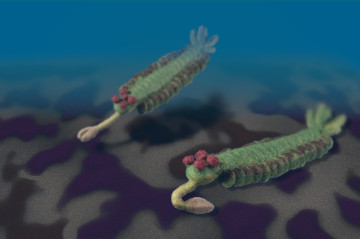

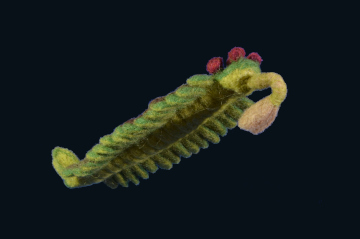
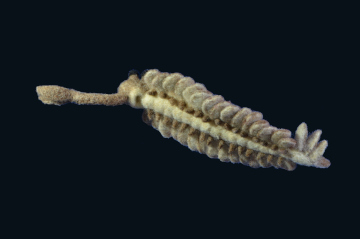
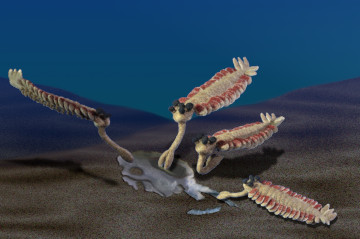
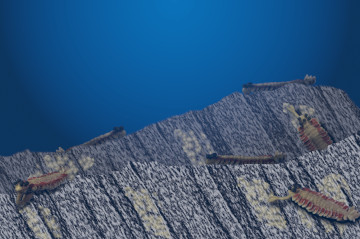

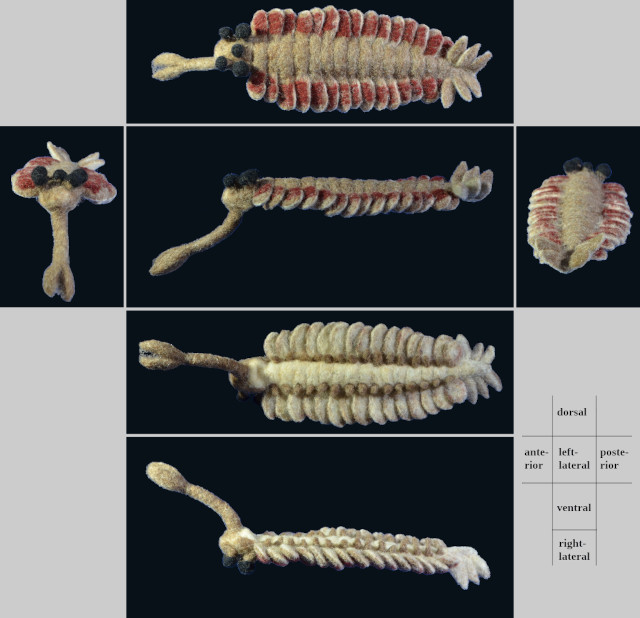
re-created in May - August 2020.